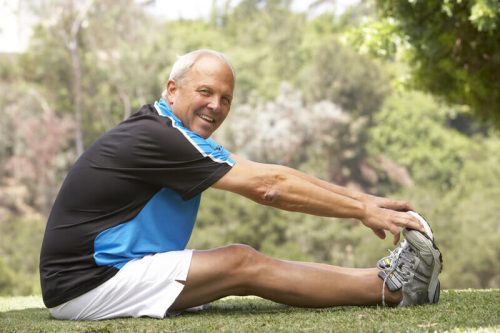Prostate enlargement is preventable, and you can minimize the risk by being more proactive. However, you may question whether or not taking exercises helps.

If you’re ever in doubt, exercising can help a great deal in preventing enlarge prostate problems. Half an hour of physical exercise every week can be handy, and you can break them into three ten-minute sessions.
However, it helps to consult your doctor to recommend the best way to approach your exercises. This article examines whether or not exercise can reduce enlarged prostate
does exercise reduce prostate enlargement: The Science Behind?
Exercising helps improve the body’s metabolism and overall body functioning. Studies have also established that exercising helps minimize the risk of prostate problems in men. Especially so exercising helps prevent the predisposition to prostate cancer, a condition that can be fatal if not diagnosed and treated early.
One 2018 study [1] recently confirmed that exercise is one of the environmental factors that have been shown to influence cancer risk, particularly prostate cancer. More findings, including one that examines the link between physical activity and BPH[2], have affirmed that men who exercise a lot aren’t predisposed to this condition as others who don’t.
Exercising may be the reason most men face an increasingly lower risk of prostate problems, which helps with the effort to help men keep their prostates in shape. Also read: Symptoms of Prostate Problems: What To Expect?
The intensity and exercise requirements can vary depending on how individuals want to approach it. Most men choose more intense exercises to keep fit and help alleviate the risk of prostate problems, which is okay.
However, a few minutes of walking in the park or jogging on the beach can help. Experts have recommended a minimum of about 30 minutes of physical activity if you want to avoid the risk of prostate problems.
Which Exercises are Best for Preventing Prostate Problems?
While all exercises are ideal for helping you minimize the risk of having prostate problems, a few targeted ones can prove more efficient and practical. These exercises target the groin and pelvic floors and can help you improve your sexual performance by preventing erectile dysfunction. Here are the best exercises you should try.
- Kegel exercises
Kegel exercises usually target the pelvic muscles, which help support the bladder and bowel function. According to a study, these exercises strengthen the pelvic floor and help with urine incontinence, a typical prostate enlargement symptom. Besides, they help with fecal incontinence and improve sexual function.
However, the key focus is that these exercises help with prostate problems, including BPH and prostate cancer. The reason for such high practicality is that these exercises work the muscles around the prostate, giving it the support it needs to function optimally. These exercises are also essential to the extent that men are scheduled for prostate surgery to make the process much simpler and more manageable.
Quick note: Prostate supplement like Prostadine is also a great way to help manage enlarged prostate issue.
How to do Kegel exercises
Kegel exercises target the groin, pelvis, and lower back. Hence, you should perform every move with your pelvis in mind. Here’s how you should do Kegel exercises effectively:
Identify the pelvic muscle – identifying the pelvic floor is easy as it’s easy to find. While urinating, try holding it back midway and release the urine to continue flowing. Try being keen while at it to identify the muscle that gets engaged. Repeat until you’re clear that you’ve identified the pelvic floor muscle.
Perform the Kegel exercise – after identifying the pelvic floor muscle, try tightening it by holding it for five seconds before releasing it. You can do that up to about 20 times in each session, which should be about three or four per day.
- Aerobics
Aerobics are low-intensity exercises for cardiovascular conditioning. They’re one of the best for preventing prostate issues, especially recurrences after diagnosing a prostate problem like cancer. Aerobics also play a significant part in making you more active sexually and improving your sexual performance significantly. Some of the best aerobic exercises include:
Walking over more extensive distances – a thirty-minute walk in the park can be enough to keep your prostate in shape and prevent the risk of getting any problems. You can vary this exercise between fast-paced walks and occasional runs. Nevertheless, you may not need to do much but stroll. Be sure to change the distance and speed to suit you.
Dancing – Sometimes, the little things you do play a significant part in keeping your prostate in perfect shape. Try adding dancing to your list of exercises to help your prostate and have fun with it.
You don’t have to dance in any specific way to target your prostate; just let off some steam while dancing to a tune. It should be for the benefits it tags along with.
Swimming – A few days a week out in the water can save your prostate and minimize the risk of getting prostate problems. Swimming is a perfect way to keep yourself active and work your muscles.
It’s good for your heart; some specific leg movements while swimming can help you build your core and back muscles. You can schedule a thirty-minute swim session on your schedule; it’ll help you protect your prostate.
Try football or soccer – You can go into the pitches if you enormously like soccer or football. -These sports are perfect ways to keep you active and have fun and help you maintain a healthy prostate.
Is Weight Training Suitable for the Prostate?
Weight training may help to help protect your prostate slightly, please don’t take it out of the equation yet. Strength training involves lifting significant weight amounts to build your body muscle.
It helps in a way that it keeps you active and enables you to churn off fat and prevent being obese. However, the goal of exercising should aim at strengthening your lower body muscles, which makes Kegels and aerobics more practical.
If you choose strength training, please ensure that it helps strengthen your lower back, core, and pelvic muscles. Deadlifts and other exercises that improve your body and lower back should help minimize the risk of prostate problems.
Considerations When Should You Exercise to Prevent Enlarge Prostate?
You don’t need more intensive body exercises to reduce the risk of prostate problems. Any activity as simple as walking and swimming can be ideal. But while at it, please pair your workouts with a healthy diet and watch what you eat to keep your prostate healthy and safe.
It would help if you also consider consulting with your health provider to recommend you the best exercise routine for your prostate. Remember that these exercises can vary depending on how you want them to help you. Also Read: Is Prostate Enlargement Serious: When Should You Seek Help?
Some activities can be way too harsh if you’re recovering from surgery than when doing them to prevent prostate problems. A trained professional should acquaint you with how you approach your exercises for better safety.
Conclusion
Exercising can help you minimize the risk of prostate problems. However, they should mainly target your pelvic area and strengthen the muscles for better support strength training may also help, but please ensure that they target your lower back and pelvic floor. Otherwise, you don’t always have to do incredibly intensive exercises but Kegels and aerobics. It would help if you also remembered to consult your health provider for professional advice about the best and most practical exercises to ensure safety and effectiveness.
- Home Remedies for Bleeding Gums: The Fastest Way To Stop It - September 29, 2023
- How to Stop Gum Bleeding Immediately: What To Do? - September 13, 2023
- Why Is Cranberry Juice Good for the Prostate:The Real Benefits - April 21, 2023




